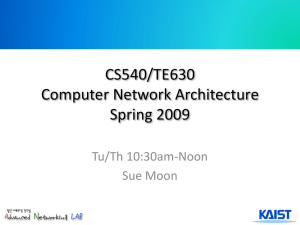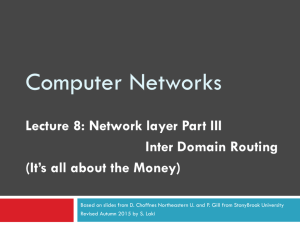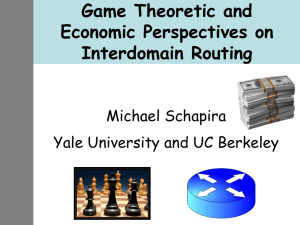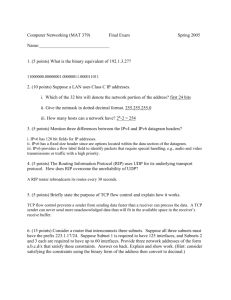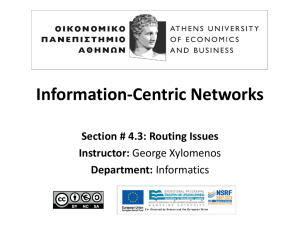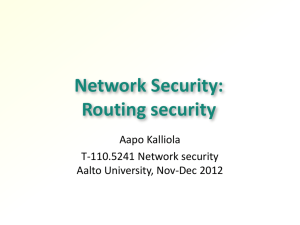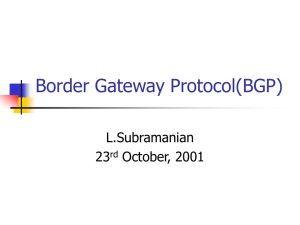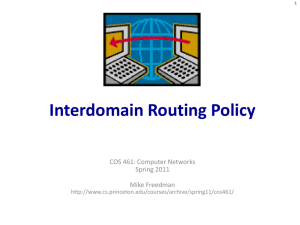Some Open Questions on the Borderline of Distributed
advertisement
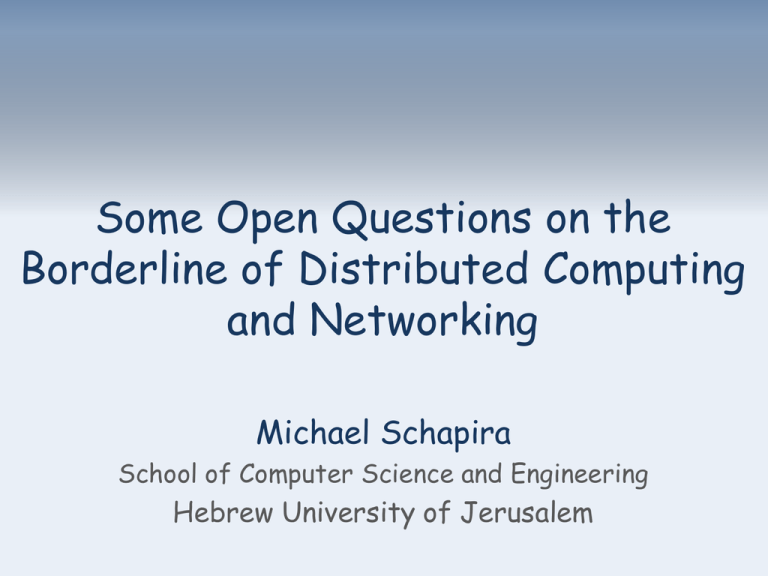
Some Open Questions on the
Borderline of Distributed Computing
and Networking
Michael Schapira
School of Computer Science and Engineering
Hebrew University of Jerusalem
This Talk
1. New questions in Internet protocol design
2. Self-stabilizing Internet protocols
3. Incentive-compatible network protocols
• … illustrated via Internet routing examples
The Internet
• Tremendous success
– from research experiment
to global infrastructure
• Enables innovation in applications
– Web, P2P, VoIP, social networks, virtual
worlds
• But, the Internet infrastructure fairly
stagnant for decades…
Why Can’t We Innovate?
• “Closed” equipment
– software bundled with hardware
– vendor-specific interfaces
• Slow protocol standardization
• Few people can innovate
– equipment vendors write the code
– long delays to introduce new features
Traditional Computer Networks
data plane:
packet streaming
Handle packets in “real time”: forward, filter, buffer,
mark, rate-limit, measure, …
Traditional Computer Networks
control plane:
distributed algorithms
slower time scale: track topology changes,
compute routes, install forwarding rules, …
Software Defined Networking (SDN):
a New Paradigm
Controller: logically-centralized control, smart,
slow, implemented in software, …
API to the data plane
(e.g., OpenFlow)
Switch: dumb, fast, implemented
in hardware
Software Defined Networking (SDN):
a New Paradigm
Controller Application
Network OS
events from switches
topology changes,
traffic statistics,
arriving packets,
…
commands to switches
(un)install rules,
query statistics,
…
8
So…
• Change is finally on the horizon
• But many challenges remain…
– Realizing SDN (e.g., distribute the controller?)
– What are the “right” protocols (for routing,
traffic engineering, etc.)?
• Distributed computing theory can play
an important role here
Distributed Controller?
Controller
Application
for scalability and
reliability
Controller
Application
partition and replicate state
Network OS
Network OS
Elect a leader?
Distribute the computation?
How to ensure consistency (across
controllers / switches)?
Where to place the controller(s)?
10
Rethinking (Routing) Protocols
• Routing is a control plane operation
– slow (milliseconds – seconds)
• Packet forwarding is a data plane operation
– fast (microseconds)
• Today’s (intradomain) routing
– establishes connectivity
– optimizes routes (= shortest paths)
• failure ⇒ re-convergence ⇒ dropped packets!
Pushing Connectivity (Only!)
to the Data Plane
• … while retaining scalability
–
–
–
–
implemented in hardware
low overhead (end-to-end backup paths too costly…)
static forwarding tables (no changes in packet rates)
no change to packet header
• When packet to a node d arrives at node i,
i’s outgoing link is a function only of
i
d
incoming link
set of “live” outgoing edges
fid: Ei x P(Ei) -> Ei
Resilient Forwarding
• A “forwarding pattern” {fid}i is t-resilient if for
any (at most) t-edge-failures the existence of a
path between a node i and the destination d
implies loop-free forwarding from i to d.
j
i
x
• Perfect resilience ≣ t →∞
d
Theoretical Perspective
• Thm [Feigenbaum-Godfrey-Panda-S-Shenker-Singla]: 1-resilient
forwarding pattern always exists
• Thm [Feigenbaum-Godfrey-Panda-S-Shenker-Singla]: Perfect
resilience is not achievable
• Big gap!
– does a 2-resilient forwarding pattern always exist?
– specific families of graphs?
– relax restrictions (randomness, dynamic forwarding
tables, …)?
Practical Perspective
A perfectly-resilient mechanism for
achieving connectivity in the data plane
– [“Data Driven Connectivity”, Liu-PandaSingla-Godfrey-S-Shenker, NSDI 2013]
– utilizes existing mechanisms
– small (few bits) changes to forwarding
tables at packet rate
Directions for Future Research
• How to distribute the controller?
• Data-plane/control-plane perspective on
other networking tasks (e.g., traffic
engineering)
• Connectivity in the data plane
(Self-)Stabilizing
Internet Routing
Border Gateway Protocol
The Border Gateway Protocol (BGP) establishes
routes between the (over 42,000) networks that
make up the Internet
AT&T
Comcast
Google
Verizon
BGP ≠ Shortest-Path Routing!
I want to avoid
routes through
Comcast if
possible
AT&T
Comcast
Google
I want a
cheap
route
I won’t carry
traffic between
AT&T and Verizon
Verizon
I want
short
routes
Illustration: BGP Dynamics
Prefer
routes
through 1
Prefer
routes
through 2
2
1
1, I’m
available
d
1, my route
is 2d
2, I’m
available
A stable state is reached
Illustration: BGP Oscillation
Prefer
routes
through 2
Prefer
routes
through 1
BGP might oscillate
indefinitely between
2
1
2, my
route
is 1d
1, my
route
is 2d
d
1, 2, I’m the
destination
Conjecture [Griffin-Wilfong, SIGCOMM 99]:
2+ stable states → BGP can oscillate
1d, 2d
and
12d, 21d
Why are Oscillations Bad?
• Make the network unpredictable and hard to
debug.
• Might lead to the flooding on the network with
BGP update messages.
• Deteriorate performance!
–
almost 50% of VoIP disruptions are due to BGP
route fluctuations
Internet Protocols, Markets, and Beyond
• Often, in computational and economic
environments
1. the prescribed behavior for each “node” (human,
machine) is simple and natural
2. nodes’ interaction is not synchronized
• How can we reason about such environments?
– Internet protocols (BGP routing, TCP congestion
control)
– large-scale markets
– social networks
–…
Dynamics:
Game Theory vs. Distributed Computing
• Game theory:
– establishes convergence to equilibrium for “natural
dynamics” (best-/better-response, fictitious play, noregret, …)
– … but typically assumes synchronization.
• Distributed computing theory:
– analyzes system behavior in asynchronous
environments
– … but no general notions of natural behavior.
Simple Model
• n nodes 1,…,n
• Node i has action space Ai
– A=A1•…•An
– A-i=A1•…•Ai-1•Ai+1•…•An
• Node i has reaction function fi:A-i→Ai
– f=(f1,…,fn)
– fi can capture node i’s “best-responses”
Simple Model (Cont.)
• Infinite sequence of discrete time steps t=1,…
• A schedule s:{1,…} →2[n] maps each time step to
the subset of nodes “activated” at that time step
– a fair schedule activates each node infinitely often
• An initial action-profile and schedule naturally
induce a dynamics.
Simple Model (Cont.)
• Defn: An action-profile a*=(a1,…,an) is a stable
state if fi(a*)=ai for all i.
– that is, a* is a fixed point of f
– abusing notation…
• Defn: A system is convergent if for every
choice of initial action-profile and fair
schedule the induced dynamics converge to a
stable state.
Towards a Characterization of
Convergent Systems
• Thm [Jaggard-S-Wright]: If there exist
multiple stable states, then the system is
not convergent.
– valency argument!
– no failures, just dumb nodes!
• So, a unique stable state is a necessary
condition for guaranteed convergence.
• Can be generalized to bounded-recall, nonstationary reaction functions.
Application: Internet Routing
• BGP establishes routes between the smaller networks that
make up the Internet
Sprint
AT&T
Comcast
Qwest
• Question [Griffin-Shepherd-Wilfong, 2001]: Do multiple stable
routing configurations imply the possibility of persistent
route oscillations?
• Answer [Sami-S-Zohar, 2009]: Yes!
Other Applications
• Our “two people in a corridor” example…
• Models of congestion control on the Internet
• Load balancing
• Diffusion of technologies in social networks
• Asynchronous circuits
• …
Meanwhile, back in the corridor…
Strengthening the Result:
Convergence vs. Synchronism
• Defn: An r-fair schedule activates each node at
least once in every r consecutive time steps
• Defn: A system is r-convergent if for all choices
of initial action-profile and r-fair schedule the
induced dynamics converges to a stable state.
– convergent r-convergent
– not r-convergence not convergent
• Thm [Erdmann-S]: If there exist multiple stable
states, then the system is not (n-1)-convergent.
– tight!
– much more delicate valency argument
Complexity of Convergent Systems
• Thm [Jaggard-S-Wright]: Determining if a system with
n nodes is convergent requires exponential
communication (in n).
• Thm [Engelberg-Fabrikant-S-Wajc]: Determining if a
succinctly described system is convergent is
PSPACE-complete.
• Both results extend also to “stochastic
convergence”.
Directions for Future Research
• Other protocols!
• Identify specific classes of (stochastically)
convergent games and measure convergence
rate (e.g., in terms of asynchronous rounds).
• Characterize guaranteed convergence, and design
algorithms for determining such convergence for
other game dynamics (e.g., fictitious play, no-regret dynamics)
other notions of equilibrium (e.g., mixed Nash, correlated)
other notions of asynchrony
Incentive-Compatible
Network Protocols
TCP Congestion Control is NOT
Incentive Compatible
queue
link
router
link
AIMD = Additive Increase Multiplicative Decrease
What About BGP?
• BGP was designed to guarantee connectivity
between largely trusted and obedient parties.
• In today’s commercial Internet ASes are owned by
self-interested, often competing, entities
– might not follow the “prescribed behaviour”
• Simple examples show that BGP is, in fact, not
incentive compatible
– a node can obtain a better route by “lying”
How Can We Fix This?
• Economic Mechanism Design: “the
reverse-engineering approach to gametheory”.
• Goal: Incentivize players to follow the
prescribed behaviour
– if others run the protocol so should I!
– without money!
• Thm [Levin-S-Zohar]: Secure variants of BGP
are incentive compatible.
Conclusion
• An exciting time to be in networking
• Internet protocols motivate new
research directions
• Distributed computing theory has much
to contribute
Thank You
